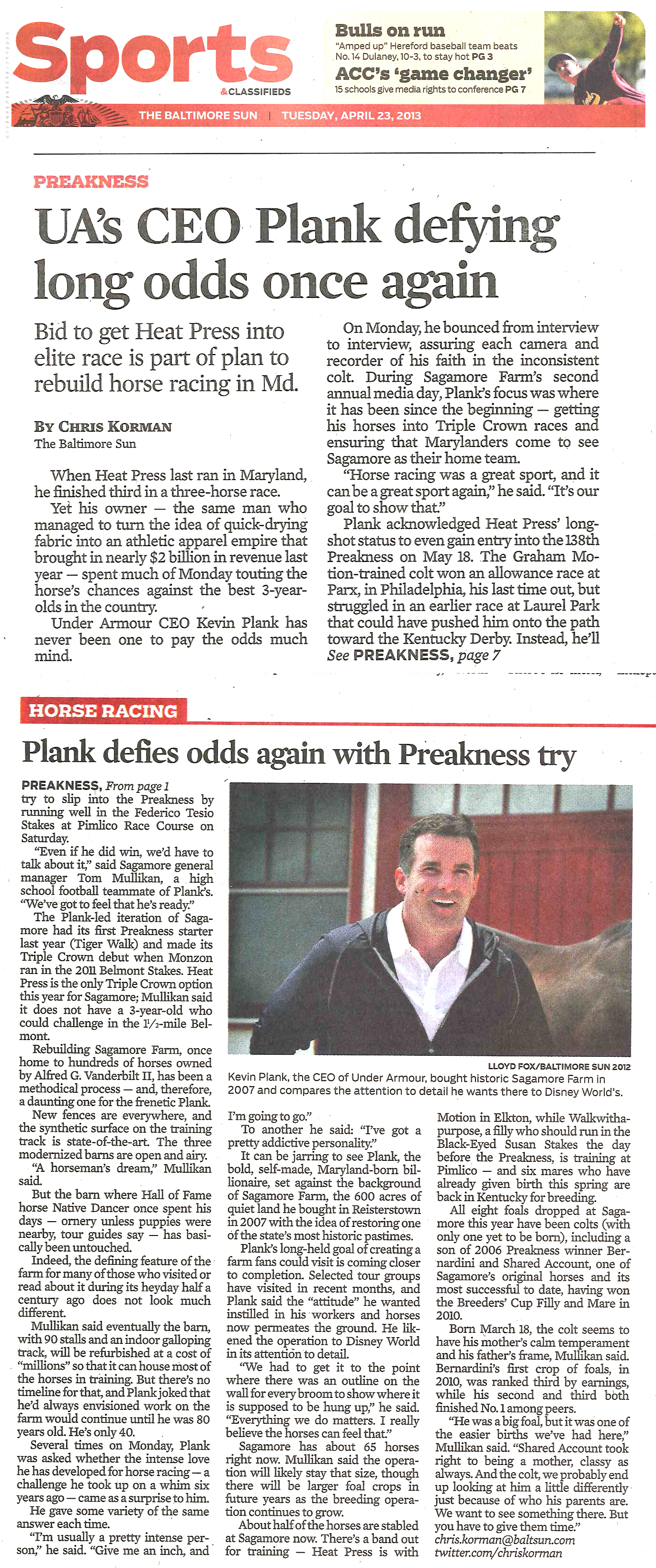 by Chris Korman
by Chris Korman
When Heat Press last ran in Maryland, he finished third in a three-horse race.
Yet his owner — the same man who managed to turn the idea of quick-drying fabric into an athletic apparel empire that brought in nearly $2 billion in revenue last year — spent much of Monday touting the horse’s chances against the best 3-year-olds in the country.
Under Armour CEO Kevin Plank has never been one to pay the odds much mind.
On Monday, he bounced from interview to interview, assuring each camera and recorder of his faith in the inconsistent colt. During Sagamore Farm’s second annual media day gathering, Plank’s focus was where it has been since the beginning — getting his horses into Triple Crown races and ensuring that Marylanders come to see Sagamore as their home team.
“Horse racing was a great sport and it can be a great sport again,” he said. “It’s our goal to show that.”
Plank acknowledged Heat Press’ long shot status to even gain entry into the 138th Preakness on May 18. The Graham Motion-trained colt won an allowance race at Parx, in Philadelphia, his last time out, but struggled in an earlier race at Laurel Park that could have pushed him onto the path toward the Kentucky Derby. Instead, he’ll try to slip into the Preakness by running well in the Federico Tesio Stakes at Pimlico Race Course on Saturday.
“Even if he did win, we’d have to talk about it,” said Sagamore general manager Tom Mullikan, a high school football teammate of Plank’s. “We’ve got to feel that he’s ready.”
The Plank-led iteration of Sagamore had its first Preakness starter last year (Tiger Walk) and made its Triple Crown debut when Monzon ran in the 2011 Belmont Stakes. Heat Press is the the only Triple Crown option this year for Sagamore; Mullikan said it does not have a 3-year old who could challenge in the mile-and-a-half Belmont.
Rebuilding Sagamore Farm, once home to hundreds of horses owned by Alfred G. Vanderbilt II, has been a methodical process — and, therefore, a duanting one for the frenetic Plank.
New fences are everywhere, and the synthetic surface on the training track is state of the art. The three modernized barns are open and airy.
“A horsemen’s dream,” Mullikan said.
But the barn where Hall of Fame horse Native Dancer once spent his days — ornery unless puppies were nearby, tour guides say — has basically been untouched.
Indeed, the defining feature of the farm for many of those who visited or read about it during its heyday half a century ago does not look much different.
Mullikan said eventually the barn with 90 stalls and an indoor galloping track will be refurbished at a cost of “millions” so that it can house most of the horses in training. But there’s no timeline for that, and Plank joked that he’d always envisioned work on the farm would continue until he was 80 years old. He’s only 40.
Several times on Monday, Plank was asked whether the intense love he has developed for horse racing — a challenge he took up on a whim six years ago — came as a surprise to him.
He gave some variety of the same answer each time.
“I’m usually a pretty intense person,” he said. “Give me an inch, and I’m going to go.”
To another he said: “I’ve got a pretty addictive personality.”
It can be jarring to see Plank, the bold, self-made, Maryland-born billionaire, set against the background of Sagamore Farm, the 600 acres of quiet land he bought in Reisterstown in 2007 with the idea of restoring one of the state’s most historic pastimes.
Plank’s long-held goal of creating a farm fans could visit is coming closer to completion. Selected tour groups have visited in recent months, and Plank said the “attitude” he wanted instilled in his workers and horses now permeates the ground. He likened the operation to Disney World in its attention to detail.
“We had to get it to the point where there was an outline on the wall for every broom to show where it is supposed to be hung up,” he said. “Everything we do matters. I really believe the horses can feel that.”
Sagamore has about 65 horses right now. Mullikan said the operation will likely stay that size, though there will be larger foal crops in future years as the breeding operation continues to grow.
About half of the horses are stabled at Sagamore now. There’s a band out for training — Heat Press is with Motion in Fair Hill, while Walkwithapurpose, a filly who should run in the Black-Eyed Susan Stakes the day before Preakness, is training at Pimlico — and six mares who’ve already given birth this spring are back in Kentucky for breeding.
All eight foals dropped at Sagamore this year have been colts (with only one yet to be born), including a son of 2006 Preakness winner Bernardini and Shared Account, one of Sagamore’s original horses and its most successful to date, having won the Breeders’ Cup Filly and Mare in 2010.
Born March 18, the colt seems to have his mother’s calm temperament and his father’s frame, Mullikan said. Bernardini’s first crop of foals, in 2010, was ranked third by earnings, while his second and third both finished No. 1 among peers.
“He was a big foal, but it was one of the easier births we’ve had here,” Mullikan said. “Shared Account took right to being a mother, classy as always. And the colt, we probably end up looking at him a little differently just because of who his parents are. We want to see something there. But you have to give them time.”
♦♦♦